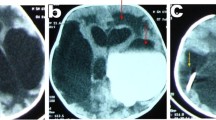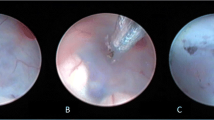Abstract
Background
Endoscopic third ventriculostomy (ETV) is a preferred mode of treatment for paediatric obstructive hydrocephalus as a result of lesions in the vicinity of the aqueduct of sylvius and posterior third ventricle. It obviates the need of implanting a foreign body inside the brain and thus reduces hardware-related complications as are seen with ventriculo-peritoneal shunts (VP).
Method
Endoscopic third ventriculostomy was done in nine cases of paediatric hydrocephalus (multiple etiologies) and the patients were followed up for a period of 18 months.
Results
In our series of nine cases, there was one ETV failure in a child of 14 months who required a conversion to VP shunt. Contusions in the fornix were seen in another patient who was of 3 months of age with post fossa tumour, but fortunately the patient did not have any gross memory deficits and was doing well after 6 months of follow-up. Intraventricular bleeding was seen in two cases which could be controlled with generous irrigation. External ventricular drain was not required in any patient. Rest of the eight patients improved slowly over the period of 6 months.
Conclusion
ETV is an attractive mode of treating obstructive hydrocephalus as it avoids the complications which can arise from implanting a foreign body. It requires a learning curve to master the technique. The literature of ETV in the paediatric population is reviewed along with our experience of nine cases of paediatric hydrocephalus with ETV.





Similar content being viewed by others
References
Choudhary A, Sobti S, Zambre S, Bhaskar S (2020) Endoscopic third ventriculostomy in failed ventriculoperitoneal shunt in pediatric population. Asian J Neurosurg 15:937–940. https://doi.org/10.4103/ajns.AJNS_117_20
Elbaba S, Steinmetz M, Ross J, Moon D, Luciano M (2001) Endoscopic third ventriculostomy for objective hydrocephalus in the pediatric population: evaluation of outcome. Eur J Pediatr Surg 11:S52–S54
Yadav YR, Jaiswal S, Adam N (2006) Endoscopic third ventriculostomy in infants. Neurol (India) 54:161–163
Ogiwara H, Dipatri AJ Jr, Alden TD, Bowman RM, Tomita T (2010) Endoscopic third ventriculostomy for obstructive hydrocephalus in children younger than 6 months of age. Childs Nerve Syst 26:343–347
Dandy WE (1918) Extirpation of the choroid plexus of the lateral ventricles in communicating hydrocephalus. Ann Surg 68:569–579. https://doi.org/10.1097/00000658-191812000-00001
Oluigbo C, Keating R (2017) Endoscopic management of hydrocephalus and choroid plexus cauterization. In: Ammar A (ed) Hydrocephalus, Springer, Cham, pp 201–208. https://doi.org/10.1007/978-3-319-61304-8_15
Mixter WJ (1923) Ventriculoscopy and puncture of the floor of the third ventricle. Boston Med Surg J 188:277–278
Putnam TJ (1934) Treatment of hydrocephalus by endoscopic coagulation of the choroid plexus. N Engl J Med 210:1373–1376
McNickle HF (1947) The surgical treatment of hydrocephalus. A simple method of performing third ventriculostomy. Br J Surg 34:302–307
Koch-Wiewrodt D, Wagner W (2006) Success and failure of endoscopic third ventriculostomy in young infants: are there different age distributions? Childs Nerv Syst 22:1537–1541
Kulkarni AV, Drake JM, Kestle JR, Mallucci CL, Sgouros S, Constantini S (2010) Predicting who will benefit from endoscopic third ventriculostomy compared with shunt insertion in childhood hydrocephalus using the ETV Success Score. Clinical article. J Neurosurg Pediatr 6:310–315
Kulkarni AV, Drake JM, Mallucci CL, Sgouros S, Roth J, Constantini S et al (2009) Endoscopic third ventriculostomy in the treatment of childhood hydrocephalus. J Pediatr 155:254-259.e1
Souweidane MM, Morgenstern PF, Kang S, Tsiouris AJ, Roth J (2010) Endoscopic third ventriculostomy in patients with a diminished prepontine interval. J Neurosurg Pediatr 5:250–254. https://doi.org/10.3171/2009.10.PEDS09187
Fukuhara T, Vorster SJ, Luciano MG (2000) Risk factors for failure of endoscopic third ventriculostomy for obstructive hydrocephalus. Neurosurgery 46:1100–1109
Cinalli G, Sainte-Rose C, Chumas P et al (1999) Failure of third ventriculostomy in the treatment of aqueductal stenosis in children. Neurosurg Focus 6:e3
Grant JA, McLone DG (1997) Third ventriculostomy: a review. Surg Neurol 47:210–212
Venkataramana NK (2011) Hydrocephalus Indian scenario—a review. J Pediatr Neurosci 6:S11–S22. https://doi.org/10.4103/1817-1745.85704
Mohanty A, Das BS, Sastry Kolluri VR et al (1996) Neuroendoscopic fenestration of occluded foramen of Monro causing unilateral hydrocephalus. Pediatr Neurosurg 25:248–251
Haldar R, Singh Bajwa SJ (2019) Potential neuroendoscopic complications: an anesthesiologist’s perspective. Asian J Neurosurg 14:621–625. https://doi.org/10.4103/ajns.AJNS_37_17
Yadav YR, Parihar V, Pande S, Namdev H, Agarwal M (2012) Endoscopic third ventriculostomy. J Neurosci Rural Pract 3:163–173. https://doi.org/10.4103/0976-3147.98222
Woodworth G, McGirt MJ, Thomas G et al (2007) Prior CSF shunting increases the risk of endoscopic third ventriculostomy failure in the treatment of obstructive hydrocephalus in adults. Neurol Res 29:27–31
Teo C, Rahman S, Boop FA et al (1996) Complications of endoscopic neurosurgery. Child Nerv Syst 12:248–253
Bouras T, Sgouros S (2013) Complications of endoscopic third ventriculostomy. World Neurosurg 79:S22.e9–S22.e12
Amini A, Schmidt RH (2005) Endoscopic third ventriculostomy in a series of 36 adult patients. Neurosurg Focus 19:E9
Gorayeb RP, Cavalheiro S, Zymberg ST (2004) Endoscopic third ventriculostomy in children younger than 1 year of age. J Neurosurg 100:427–429
Etus V, Ceylan S (2005) Success of endoscopic third ventriculostomy in children less than 2 years of age. Neurosurg Rev 28:284–288
Drake J, Chumas P, Kestle J, Pierre-Kahn A, Vinchon M, Brown J et al (2006) Late rapid deterioration after endoscopic third ventriculostomy: additional cases and review of the literature. J Neurosurg 105:118–126
Drake JM, Canadian Pediatric Neurosurgery Study Group (2007) Endoscopic third ventriculostomy in pediatric patients: the Canadian experience. Neurosurgery 60:881–886
Kadrian D, van Gelder J, Florida D, Jones R, Vonau M, Teo C et al (2008) Long-term reliability of endoscopic third ventriculostomy. Neurosurgery 62:614–621
Warf BC (2005) Comparison of endoscopic third ventriculostomy alone and combined with choroid plexus cauterization in infants younger than 1 year of age: a prospective study in 550 African children. J Neurosurg 103:475–481
Warf BC (2005) Hydrocephalus in Uganda: the predominance of infectious origin and primary management with endoscopic third ventriculostomy. J Neurosurg 102:1–15
Baldauf J, Oertel J, Gaab MR, Schroeder HW (2007) Endoscopic third ventriculostomy in children younger than 2 years of age. Childs Nerv Syst 23:623–626. https://doi.org/10.1007/s00381-007-0335-4
Teo C, Jones R (1996) Management of hydrocephalus by endoscopic third ventriculostomy in patients with myelomeningocele. Pediatr Neurosurg 25:57–63
Jallo GI, Kothbauer KF, Abbott IR (2005) Endoscopic third ventriculostomy. Neurosurg Focus 19:E11
Durnford AJ, Kirkham FJ, Mathad N, Sparrow OC (2011) Endoscopic third ventriculostomy in the treatment of childhood hydrocephalus: validation of a success score that predicts long-term outcome. Clinical article. J Neurosurg Pediatr 8:489–493
Naftel RP, Reed GT, Kulkarni AV, Wellons JC (2011) Evaluating the Children’s Hospital of Alabama endoscopic third ventriculostomy experience using the Endoscopic Third Ventriculostomy Success Score: an external validation study. Clinical article. J Neurosurg Pediatr 8:494–501
Hader WJ, Walker RL, Myles ST et al (2008) Complications of endoscopic third ventriculostomy in previously shunted patients. Neurosurgery 63:ONS168–ONS174
Author information
Authors and Affiliations
Corresponding author
Rights and permissions
About this article
Cite this article
Kataria, R., Mehrotra, M., Purohit, D.K. et al. Endoscopic third ventriculostomy in the paediatric population. J Ped Endosc Surg 3, 183–192 (2021). https://doi.org/10.1007/s42804-021-00117-6
Received:
Revised:
Accepted:
Published:
Issue Date:
DOI: https://doi.org/10.1007/s42804-021-00117-6




